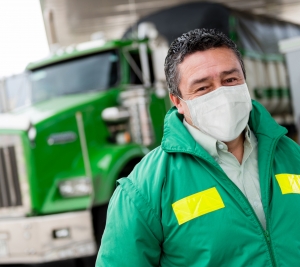
As COVID-19 case numbers reach nearly 7 million worldwide, every state across the U.S. is deciphering how to best navigate through the pandemic.
At a glance, here’s where the U.S. stands on the coronavirus today:
- The country sees roughly 20,000 new cases a day
- As of June 4, the U.S. has nearly 1.9 million cases — the highest of any country in the world
- As of late May, the country’s unemployment number stands at 42.6 million
With these numbers dominating the state of the country, ‘business as usual’ is a thing of the past. Many places of business that rely on customer deliveries, like Domino’s, Uber, and Amazon, have implemented contactless delivery to protect their employees and customers.
The distribution industry is no different. Companies are working to adapt to the new tides of the near-future, and contactless delivery has been gaining traction. As more and more distribution and logistics companies will likely follow suit, the question posed is: What are the best ways to go contactless?
It starts with technology
From food delivery to online shopping, going contactless is made possible through the use of technology. Mobile technology has simplified the transaction process for many. Ordering food through an app was common before the pandemic, but utilizing an option to leave meals at the door is a new development that has become very widespread. Given the convenience of this option, it’s one that may be here to stay.
For distribution companies, utilizing technology solutions that encourage contactless delivery is imperative. For example, Omnitracs Proof of Delivery, allows you to collect electronic signatures and eliminate the use of hand-to-pen-to-hand interaction, or optionally not require signature capture at all.
You can also use Omnitracs Active Alert to customize your messaging to communicate to customers what to expect. Also, you can use proactive alerts to automatically send ETA and delivery notifications so that, even if you do leave deliveries at the door, customers know when to pick their orders up.
With technology, the possibilities can be endless with a highly customizable workflow and tasks.
Responsibility should be shared company-wide
Drivers are the ones who typically come face-to-face with customers; however, the responsibility doesn’t solely fall on them. Drivers need proper, contactless-focused training and resources, and customers need effective communication.
Below are a few areas to focus on:
- Dedicate a page on your website to ways you’re going contactless. Emphasize to your customers that you’re doing so for their safety and the safety of your employees. Once you have that page ready, it may serve you well to send an email to your customers to re-emphasize the same points. You can check out our safety commitment page to see an example of how we’re doing this.
- Make sure to equip your drivers with the resources and information they need to go contactless, such as a virtual training that focuses on socially-distanced deliveries.
- Customize your solutions to go contactless. One way to do this is to incorporate a no-signature- required delivery option to eliminate the exchange of pens. Depending on the nature of your business and which solutions you’re using, you can also incorporate a leave-at-door delivery option.
Should we focus on going contactless for the short or long term?
It may take years to understand the full impact this pandemic will have on our long-term lives. In some ways, we may revert to what we previously knew as usual, but in many others, the way we conduct business may change permanently.
We only have to look at the convenience that contactless delivery has brought for customers. As customers are more likely to convert their standards as opposed to reverting them, it may be safe to say that — even after COVID-19 is long gone — contactless delivery will be here to stay. As with everything in this new era we’ve found ourselves in, only time will tell.
Continue checking in to our Road Ahead Blog for more related industry coverage. In the meantime, learn about how we’re leveraging data to support our customers amidst COVID-19.
